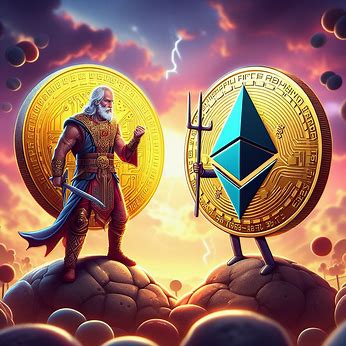Ethereum has been a leading crypto participant for many years, but is it still worth investing in? With major upgrades and expanding uses, Ethereum looks composed for growth in 2024 and beyond. Here are 10 reasons to buy ethereum in 2024.
1. The Ethereum Merge and Proof-of-Stake Transition
One of the biggest developments for Ethereum is its upcoming transition from a proof-of-work (PoW) to a proof-of-stake (PoS) consensus mechanism, known as “The Merge.” This shift, expected to be completed by 2024, aims to make Ethereum more scalable, secure, and sustainable.
Under PoS, validators will “stake” their ETH to verify transactions and create new blocks, replacing the energy-intensive mining process. This is projected to reduce Ethereum’s energy consumption by up to 99.95%, making it more environmentally friendly and appealing to eco-conscious investors.
The merger also lays the groundwork for future upgrades like sharding, which will further improve Ethereum’s efficiency and capacity. As these improvements roll out, Ethereum’s value and adoption could rise, making 2024 an opportune time to invest.
2. Growing the DeFi Ecosystem
Decentralized finance (DeFi) has increased dramatically on Ethereum, with the network hosting the majority of DeFi protocols and total value locked (TVL). From lending and borrowing platforms to decentralized exchanges (DEXs) and yield farming, Ethereum’s DeFi is growing.
As more users seek alternatives to traditional financial services, Ethereum’s DeFi ecosystem is well-positioned for continued growth. Investing in ETH provides exposure to this rapidly growing sector, which could drive demand for the cryptocurrency in the coming years.
3. Expanding NFT and Gaming Applications
Ethereum has become the go-to platform for non-fungible tokens (NFTs) and blockchain gaming. NFTs, which represent unique digital assets like art, collectibles, and virtual real estate, have gained massive popularity, with many of the most valuable NFTs residing on the Ethereum blockchain.
Similarly, Ethereum has attracted numerous blockchain gaming projects, enabling traders to own, trade, and monetize in-game assets as NFTs. As the NFT and gaming industries continue to grow, Ethereum’s role as a leading platform could drive further demand for ETH.
4. Institutional Adoption and Investment
Institutional investors and major corporations are increasingly recognizing Ethereum’s potential. Companies like Microsoft, IBM, and JPMorgan have begun building on the Ethereum blockchain for various applications, from supply chain management to financial services. Additionally, institutional investment in Ethereum has increased, with more funds, family offices, and traditional financial institutions allocating funds to ETH. As the institution grows, it could provide a significant boost to Ethereum’s value in 2024 and beyond.
5. Stablecoins and Global Payments
Ethereum has become the foundation for many stablecoins and cryptocurrencies hold down to the value of fiat currencies or other assets. Stablecoins like USD Coin (USDC) and Dai (DAI) have built momentum as a means of secure, borderless, and low-cost global payments.
As stablecoins continue to gain mainstream acceptance, Ethereum’s role as the underlying infrastructure could drive demand for ETH. Moreover, Ethereum’s upcoming upgrades could make stablecoin transactions faster and cheaper, further boosting adoption.
6. Ethereum’s Developer Community and Ecosystem
Ethereum boasts the largest and most active developer community in the blockchain space. This ecosystem of developers, projects, and tools has been a key driver of innovation and growth on the platform.
As more developers flock to Ethereum to build decentralized applications (dApps), the network’s value and utility could continue to grow. This growing developer community also contributes to the platform’s resilience and adaptability, ensuring that Ethereum remains at the forefront of blockchain technology.
Related: How to Buy Bitcoin for the First Time
7. Ethereum’s Deflationary Model
With the introduction of EIP-1559 in the London hard fork, Ethereum implemented a new fee structure that includes burning a portion of transaction fees. This mechanism reduces the supply of ETH over time, potentially making it a deflationary asset.
As demand for Ethereum grows and supply decreases, the value of ETH could appreciate. This deflationary model could make Ethereum an attractive long-term investment, especially as the network’s scalability and efficiency improve.
8. Interoperability and Layer 2 Solutions
Ethereum is working on improving interoperability with other blockchains through initiatives like the Ethereum Interoperability Alliance and the development of cross-chain protocols. These efforts aim to enable seamless communication and asset transfer between Ethereum and other networks, expanding its ecosystem and potential use cases.
Additionally, Ethereum’s Layer 2 scaling solutions, such as Optimistic Rollups and ZK-Rollups, are gaining traction. These solutions allow for faster and cheaper transactions while still using Ethereum’s security and decentralization. As these technologies mature, they could further boost Ethereum’s adoption and value.
9. Decentralized Autonomous Organizations (DAOs)
Decentralized autonomous organizations (DAOs) are a growing trend in the Ethereum ecosystem. DAOs are collectively owned and managed by their members, with decision-making and resource allocation governed by smart contracts.
As more organizations finds the potential of DAOs for decentralized governance, fundraising, and community building, Ethereum’s role as the leading platform for DAOs could drive demand for ETH. Investing in Ethereum provides exposure to this growing organizational model and its potential impact on various industries.
10. Ethereum’s Long-Term Vision and Roadmap
Ethereum has a clear long-term vision and roadmap for growth, with a focus on scalability, security, and sustainability. The Ethereum 2.0 upgrades, which include the merger and sharding, are set to address the network’s current limitations and lay the foundation for future growth.
As Ethereum continually gain momentum and adapts to the changing needs of the blockchain industry, its long-term prospects remain strong. Investing in ETH in 2024 could provide exposure to the potential upside of these ongoing developments and Ethereum’s future growth.
Key Takeaways
1. Ethereum’s upcoming transition to proof-of-stake (The Merge) will make it more scalable, secure, and environmentally friendly, potentially driving up its value.
2. The growing DeFi ecosystem on Ethereum positions it for continued growth as more users seek alternatives to traditional finance.
3. Ethereum’s dominance in the NFT and blockchain gaming industries could further drive demand for ETH.
4. Increasing institutional adoption and investment in Ethereum demonstrate its potential and could provide a significant boost to its value.
5. Ethereum’s role as the foundation for stablecoins and global payments could increase demand for ETH as these use cases gain mainstream acceptance.
6. Ethereum’s large and active developer community continues to drive innovation and growth on the platform.
7. The introduction of a deflationary model through EIP-1559 could make ETH an attractive long-term investment.
8. Improvements in interoperability and the development of Layer 2 scaling solutions could expand Ethereum’s ecosystem and use cases.
9. The growth of decentralized autonomous organizations (DAOs) on Ethereum could drive demand for ETH as more organizations find this new model.
10. Ethereum’s clear long-term vision and roadmap, focused on scalability, security, and sustainability, position it for future growth and success.
Frequently Asked Questions
1. What is Ethereum, and how does it differ from Bitcoin?
Ethereum is a decentralized, open-source blockchain platform that enables the creation of smart contracts and decentralized applications (dApps). While Bitcoin is primarily used as a digital currency, Ethereum’s programmable blockchain allows for a more use cases, such as DeFi, NFTs, and DAOs.
2. What is the Ethereum Merge, and why is it significant?
The Ethereum Merge refers to the network’s transition from a proof-of-work (PoW) to a proof-of-stake (PoS) consensus mechanism. This upgrade is expected to make Ethereum more scalable, secure, and energy-efficient, potentially driving up its value and adoption.
3. What are the risks associated with investing in Ethereum?
Like any cryptocurrency investment, investing in Ethereum comes with risks. These include market volatility, regulatory uncertainty, and potential security vulnerabilities. It’s very important for you to always make your own research and understand these risks before investing and never invest more than you can afford to lose.
4. How can I invest in Ethereum?
You can invest in Ethereum by purchasing ETH on a cryptocurrency exchange, such as Coinbase, Binance, or Kraken. Alternatively, you can invest in Ethereum-based funds or ETFs, which provide exposure to ETH without the need to directly manage the cryptocurrency.
5. What is DeFi, and how does it relate to Ethereum?
DeFi, or decentralized finance, refers to financial applications built on blockchain technology that aim to provide alternatives to traditional financial services. Ethereum hosts the majority of DeFi protocols, and the growth of this ecosystem could drive demand for ETH.










